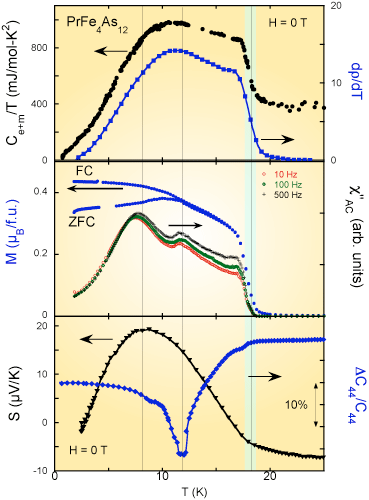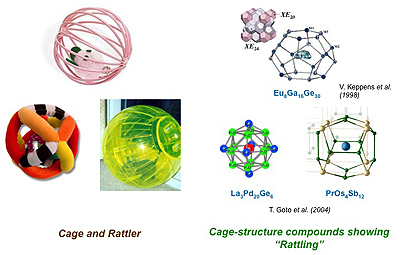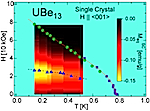Abstract
|
Thermodynamic and transport studies of the ferromagnetic filled skutterudite compound PrFe4As12 T. A. Sayles, W. M. Yuhasz, J. Paglione, T. Yanagisawa, J.R. Jeffries, M.B. Maple, Z. Henkie, A. Pietraszko, T. Cichorek, R. Wawryk, Y. Nemoto and T. Goto |
|
A variety of thermodynamic and transport measurements were made on high-quality single crystals of the Pr-based filled skutterudite compound PrFe4As12. Abrupt features in magnetization, ac susceptibility, specific heat, resistivity, thermoelectric power, and ultrasonic velocity reveal the onset of long range ferromagnetic order below ThetaC=18 K. The low-temperature magnetic susceptibility is characterized by a Curie–Weiss law with an effective moment of 3.52µB/f.u. and a saturation magnetization of 2.3µB/f.u., which is consistent with a magnetic Γ5 triplet ground state. A gaplike reduction of the large electronic specific heat coefficient of 340 mJ/mol K2 and several other features point to a strongly correlated electron behavior that is likely coupled to a change in magnetic and/or structural order near T*~12 K. Furthermore, this complex magnetic state is found to be strongly field dependent, as evidenced by a change in the easy axis at low fields and an additional contribution to thermal conductivity appearing only at high fields. Phys. Rev. B 77 (2008) 144432. (Editor's Suggested).
Figure : A comparison of low-temperature specific heat, electrical resistivity, magnetization, ac susceptibility, Upper: Temperature derivative of resistivity and electronic plus magnetic contributions to specific heat, which shows a striking resemblance of the temperature dependence of each throughout the entire range. Middle: Low-field (5 mT) dc magnetization and the imaginary part of the ac susceptibility, highlighting the coincidence of both the irreversibility temperature in M(T) and the peak in Chi_ac(T) with T*. Lower* Zero-field thermoelectric power and relative change in the elastic constant ΔC44/C44 as a function of temperature for PrFe4As12. (* This research was performed at UC San Diego and Niigata University in 2006-2007) |







